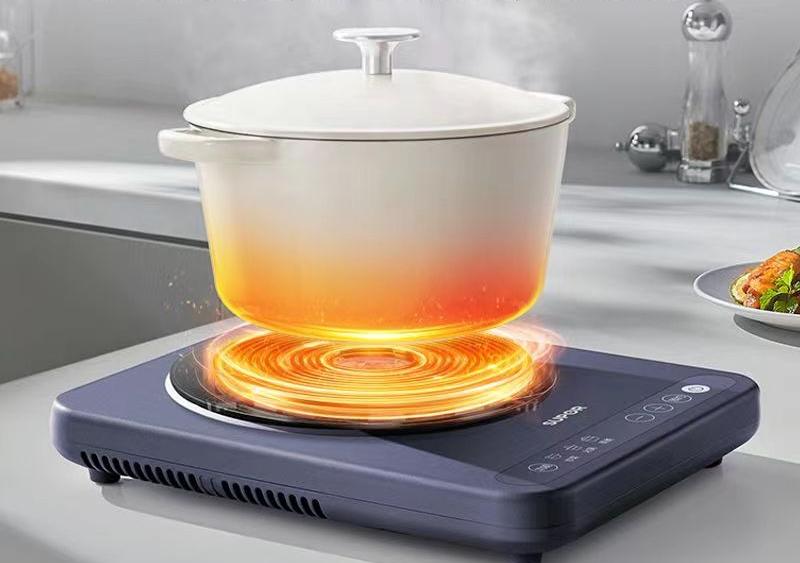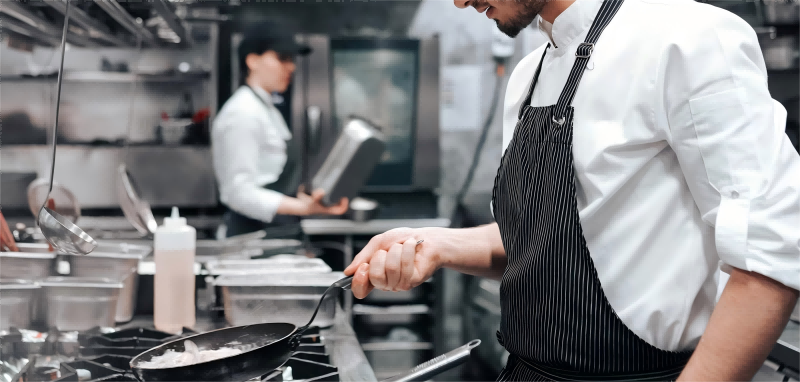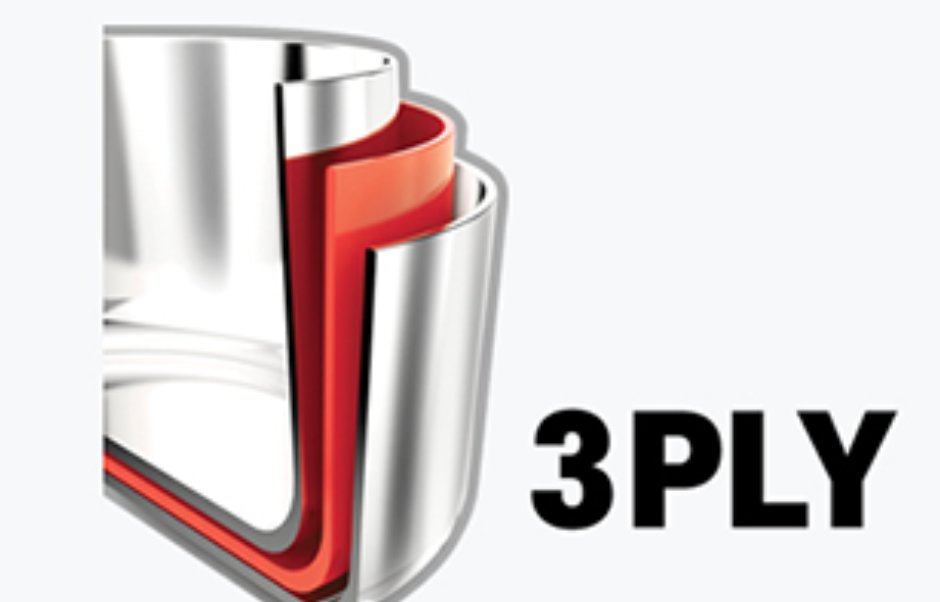شركة بيور كوك لتصنيع أدوات المطبخص يأخذك في نظرة متعمقة على ظهور تقنية الطهي بالحث وكيف يمكن لأواني الطهي المصنوعة من الفولاذ المقاوم للصدأ المخصصة أن تعزز تجربة الطهي الحديثة.
مقدمة
يحدث تحول ضخم في مجال الطهي مدفوعًا بالتكنولوجيا وسلوك المستهلك. ويقود هذا التغيير موقد الحث، وهو جهاز يوفر أقصى درجات الكفاءة والدقة والأمان عندما يتعلق الأمر بالطهي. ومع تطلع أصحاب المنازل والطهاة المحترفين على حدٍ سواء إلى تحديث مطابخهم وإدخال الطهي بالحث الحثي في الصورة، أصبح التوافق مع هذه التقنية حقيقة شرائية رئيسية، خاصةً مع أواني الطهي. إذا كانت أواني الطهي مصممة خصيصًا لتلبية احتياجات الطهي الخاصة بك، فإن أواني الطهي المصنوعة من الفولاذ المقاوم للصدأ هي واحدة من أفضل الاختيارات بسبب متانتها وجاذبيتها العالمية.
في هذا المقال، نناقش في هذه المقالة سبب اكتساب المواقد الحثية المزيد والمزيد من الإقبال، وما هي المشكلة المتعلقة باستخدام أواني الطهي المصنوعة من الفولاذ المقاوم للصدأ على مواقد الحث الحثي، وما إذا كان من الأفضل شراء أواني طهي مخصصة تعمل بالحث أو بالأحرى مواقد الطهي. يهدف التحليل الكامل المميز إلى تزويد القراء بالمعلومات التي يحتاجون إليها لاتخاذ قرار جيد في المرة القادمة التي يرغبون فيها باستبدال أجهزة المطبخ أو أواني الطهي الخاصة بهم.
ظهور المواقد الحثية
إنه تقدم تكنولوجي على أجهزة الطهي.
تعتبر المواقد الحثية قفزة (إلى الأمام!) في تكنولوجيا الطهي. تولد مواقد الحث الحثي الحرارة مباشرة في أواني الطهي نفسها بدلاً من التوصيل الحراري من اللهب أو عنصر التسخين إلى أواني الطهي، وهي الطريقة التي يعمل بها موقد الغاز أو الموقد الكهربائي التقليدي. وتوفر هذه الطريقة في توليد الحرارة فوائد متعددة:
الكفاءة: يتمتع موقد الحث الحثي بحوالي 841 تيرابايت 3 تيرابايت من كفاءة نقل الطاقة بينما يحترق الغاز بحوالي 401 تيرابايت 3 تيرابايت، بينما تنقل المواقد الكهربائية التقليدية حوالي 741 تيرابايت 3 تيرابايت من الطاقة. ونتيجةً لذلك، سوف تستهلك طاقة أقل بكثير وستكون فواتير المرافق أقل إيلاماً بكثير.
تسخين سريع: تسخن أواني الطهي بشكل أسرع لأن نقل الطاقة يحدث مباشرة. فيتم طهي الطعام بشكل أسرع، ويغلي الماء بشكل أسرع، وبالتالي يتم تقليل وقت الوجبة.
تحكم دقيق في درجة الحرارة: توفر المواقد الحثية تغيرات فورية ودقيقة في درجة الحرارة، مما يتيح للطهاة المزيد من التحكم في عملية الطهي.
ميزات السلامة - نظرًا لأن الموقد نفسه لا يسخن بشدة، فإن فرص حدوث حروق منخفضة جدًا. كما أن المواقد الحثية عادةً ما تحتوي على خاصية الإغلاق التلقائي التي تعمل على إطفاء الموقد عند عدم وجود وعاء.

اتجاهات السوق وتفضيلات المستهلكين
يُظهر موقد الطهي التعريفي أيضًا نموًا قويًا في جميع أنحاء العالم تماشيًا مع التطور العام لسوق أجهزة المطبخ. تشير مقتطفات من تقرير صادر عن Grand View Research (2021) إلى أنه من المتوقع أن يصل حجم السوق إلى 27.3 مليار دولار أمريكي بحلول عام 2028، بمعدل نمو سنوي مركب يبلغ 8.11 تيرابايت على مدى الفترة من 2021 إلى 2028. هناك عدد من الأسباب لذلك
- القضايا البيئية: مع ازدياد وعي المستهلكين أكثر فأكثر، فإنهم يرغبون في شراء الأجهزة التي تفيد البيئة من خلال استخدام طاقة أقل وانبعاثات أقل من ثاني أكسيد الكربون.
- مظهر معاصر: تتمتع المواقد الحثية في الوقت الحاضر بمظهر أنيق للغاية وبسيط يتناسب بشكل جميل مع أسلوب ديكور المطبخ.
- التحضر والمساحة الأقل: يمكن لأسطح الطهي الحثية ذات المساحة الأقل أن تناسب منازل أنماط الحياة الحضرية حيث مساحة المطبخ أقل.
- تحسين الصحة والسلامة: لا توجد ألسنة لهب مكشوفة، مما يعني تقليل تلوث الهواء الداخلي ومخاطر الحريق.

الاعتماد في المطابخ الاحترافية
ومع ذلك، يتم اعتماد تقنية الحث الحثي أيضًا من قبل محترفي الطهي والمطابخ التجارية. حيث يضمن الطهي بالحث الحثي جودة وسرعة أفضل في الطهي؛ كما أنه يوفر بيئة عمل أكثر برودة في المطبخ في ظل ظروف العمل. والآن، أصبحت مدارس الطهي الرائدة تستخدم المواقد الحثية بشكل متزايد في تدريبها، وهي خطوة تضع معايير جديدة في هذا المجال.
الفولاذ المقاوم للصدأ: متى تستخدمه وفوائده.
لماذا تحظى أواني الطهي المصنوعة من الفولاذ المقاوم للصدأ بشعبية كبيرة؟
غالبًا ما تكون أواني الطهي هي أكثر أنواع أدوات المطبخ المصنوعة من الفولاذ المقاوم للصدأ تفضيلاً بفضل:
- المتانة: تُعد أواني الطهي المصنوعة من الفولاذ المقاوم للصدأ خياراً يدوم طويلاً لأنها تقاوم الصدأ والتآكل والبقع.
- لا يتفاعل: يبقى متعادلاً مع الأطعمة الحمضية أو القلوية، والوصفات العادية قادرة على الحفاظ على نكهته.
- سهلة الصيانة: نظراً لأن الأسطح المصنوعة من الفولاذ المقاوم للصدأ آمنة للغسل في غسالة الأطباق في الغالب، فيمكن تنظيفها وصيانتها بسهولة.
- السمات الجمالية: تمنح الطبيعة النظيفة واللامعة للفولاذ المقاوم للصدأ المطابخ مظهراً احترافياً.
اكتساب شعور أعمق بالتوافق التعريفي
لا يمكن استخدام جميع الأواني والمقالي على موقد الحث الكهرومغناطيسي؛ في الواقع فقط أواني الطهي التي لها خصائص مغناطيسية هي التي تفي بالغرض. يخلق الموقد الحثي مجالاً كهرومغناطيسياً يحرك تياراً كهربائياً في أواني الطهي ويولد حرارة. وبالتالي، يجب أن تكون أواني الطهي مصنوعة من مواد مغناطيسية مغناطيسية (الحديد أو الفولاذ المقاوم للصدأ المغناطيسي).
أنواع الفولاذ المقاوم للصدأ
هناك العديد من الدرجات والتركيبات المختلفة للفولاذ المقاوم للصدأ:
- الفولاذ المقاوم للصدأ الأوستنيتي (السلسلة 300): يحتوي على نسبة عالية من الكروم والنيكل لمقاومة عالية للتآكل - غير مغناطيسي بطبيعته
- حديدية SS (السلسلة 400): تحتوي على نسبة عالية من الكروم ولكنها منخفضة جدًا إن لم تكن منعدمة في النيكل، وبالتالي فهي مغناطيسية حديدية وقادرة على الحث.
الآن ليست كل أواني الطهي المصنوعة من الفولاذ المقاوم للصدأ ملائمة للحث الحراري. تعامل المصنعون مع هذه المشكلة من خلال تضمين طبقة مغناطيسية في قاعدة أواني الطهي.
اختبار أواني الطهي للاستخدام الحثي
إليك ما يجب أن تبحث عنه في أفضل أواني الطهي المصنوعة من الفولاذ المقاوم للصدأ للاستخدام على موقد الحث الكهرومغناطيسي:
- بقايا مغناطيسية: تحققي مما إذا كانت أواني الطهي مكتوب عليها "جاهز للحث الكهرومغناطيسي" أو "متوافق مع الحث الكهرومغناطيسي"، مما يعني أنها تحتوي على طبقة مغناطيسية.
- هيكل متين: بنية متعددة الطبقات أو مكسوة؛ يمكن أن تساعد الطبقات المعدنية في توزيع الحرارة وتحسين الأداء.
- سطح قاعدة مسطح: يوفر تلامسًا كاملاً مع موقد الحث الكهرومغناطيسي بحيث يحدث أقصى قدر من نقل الطاقة.
وصلت أواني الطهي المصنعة
احتياجات الطهي الشخصية
لكل طباخ أذواقه واحتياجاته الخاصة التي تعتمد على أسلوب الطهي والوصفات وتجهيز المطبخ. تلبي أواني الطهي المخصصة المتطلبات الفريدة للفرد من خلال درجة من التخصيص في:
- تصميم المواد: استخدام درجات معينة من الفولاذ المقاوم للصدأ، أو خلائط معدنية للحصول على الخواص الحرارية المطلوبة.
- مواصفات التصميم: الحجم والشكل ويمكنك تعديل شكل المقبض والغطاء لجعله أكثر سهولة في الاستخدام.
- إضافات عملية: مثل علامات القياس أو فوهات السكب أو المقابض المصممة بشكل مريح.
فوائد أواني الطهي المخصصة على موقد الحث الحراري
هناك بعض المزايا لشراء أواني الطهي المخصصة، وهي:
- وظائف مضمونة يمكن تصميم أواني الطهي المخصصة خصيصًا لتكون متوافقة مع الحث الكهرومغناطيسي حتى لا تقلق بشأن الخصائص المغناطيسية.
- الأداء: تم تحسين سُمك وتصميم أواني الطهي من أجل توزيع الحرارة والاحتفاظ بها، مما يؤدي إلى أداء طهي أفضل.
- تناسب الديكور المحيط بالمطبخ: يمكن أن تتناسب التصاميم المخصصة دائمًا مع ديكور المطبخ وشخصية الطاهي، للحصول على مظهر أكثر تناسقًا بسلاسة.
- المتانة والاستدامة: تضمن عملية تصنيع المواد عالية الجودة متانتها مع عدد أقل من عمليات الاستبدال.
أمثلة على ذلك: حلول أواني الطهي المخصصة
الطهاة المحترفون
يمكن أن يستفيد الطاهي اليومي من أواني الطهي التي تتحمل الاستخدام اليومي الصارم وتوفر الدقة. يمكن تصميم أواني الطهي المعدنية المخصصة بحيث تحتوي على تعزيزات هيكلية وتركيبات معدنية معينة لتتحمل كل ذلك.

عشاق الطهي المنزلي
على سبيل المثال، قد يحتاج الطباخ المنزلي الذي يحب طهي مأكولات معينة إلى معدات خاصة؛ مقلاة ذات قاع مسطح لتناسب التسخين باستخدام موقد الحث الحراري. إن التصاميم المصممة خصيصًا هي ما يجعل تطبيق التقاليد على التكنولوجيا الحديثة.
الفحص الشامل لمواد الطهي بالحث الحثي ومواد وعاء الحث.
أداء أواني الطهي والتوصيل الحراري
يتلخص أداء أواني الطهي على المواقد الحثية في التوصيل الحراري، أو مدى سرعة انتقال الحرارة عبر المادة. تشمل المعادن غير المغناطيسية ذات الموصلية الحرارية العالية النحاس والألمنيوم. يناسبها المتانة والجوانب المغناطيسية للفولاذ المقاوم للصدأ، على الرغم من انخفاض التوصيل الحراري.
بناء متعدد الطبقات
من خلال البناء متعدد الطبقات، يوازن المصنعون بين هذه الخصائص:
- أواني الطهي ثلاثية الطبقات: تحتوي على طبقة من الألومنيوم أو النحاس محصورة بين طبقتين أخريين من الفولاذ المقاوم للصدأ. يدمج التصميم بين التوصيل الحراري للألومنيوم والنحاس مع الفولاذ المقاوم للصدأ المتين والمصنوع من الألومنيوم والنحاس.
- قاعدة ملتصقة بالقاعدة: يحتوي على قرص من الألومنيوم أو النحاس ملتصق بقاعدة أواني الطهي المصنوعة من الفولاذ المقاوم للصدأ، مما يسمح بتوزيع الحرارة دون التأثير على التوافق مع الحث الحراري.
أداء الحث الحثي وبنية أواني الطهي.

تتأثر كفاءة الطهي بالحث الحثي بما يلي:
- حجم أواني الطهي وشكلها: لكي تعمل أواني الطهي بكفاءة، يجب أن تتماشى أواني الطهي مع حجم الموقد الحثي.
- سُمك المادة: قد تؤدي المواد الأكثر سُمكًا إلى تبديد الحرارة بشكل متساوٍ أكثر، ولكنها قد تجعل تغيرات درجة الحرارة أبطأ أيضًا!
- سطح مستوٍ: يسمح القاع المسطح بتلامس ثابت مع سطح الطهي، وهو أمر مهم لنقل الطاقة لطهي الطعام بكفاءة.
السلامة والامتثال التنظيمي
يجب أن تتوافق أواني الطهي المخصصة مع معايير السلامة والمعايير التنظيمية:
- لوائح سلامة الأغذية-يجب أن تكون المواد المستخدمة آمنة للتلامس مع الأغذية ولا تحتوي على مواد ضارة مثل الرصاص أو الكادميوم.
- معايير التصنيع: تضمن معايير مراقبة الجودة التي تُصنع بها أواني الطبخ أداء أواني الطبخ.
- لأجهزة الطهي بالحث الحثي: يحتاج المصنعون إلى اختبار منتجاتهم واعتمادها من أجل استخدامها على أفران الحث الكهرومغناطيسي، مما يمنح المستهلكين راحة البال.
اعتبارات عملية للمستهلكين.
تقييم عادات الطهي
قبل الانتقال إلى المواقد الحثية وأواني الطهي التي تعمل معها، يجب على المستهلكين مراعاة ما يلي:
- كم مرة تطبخين: قم بتقييم ما إذا كانت مزايا الطهي بالحث الحثي تتوافق مع عادات الطهي الخاصة بك على أساس يومي.
طريقة الطهي: تميل بعض طرق الطهي إلى الإنجاز بشكل أفضل مع الحث الحثي، حيث تتطلب هذه الطرق تحكمًا دقيقًا في درجة حرارة الطهي.
- مخزون الحث الحثي: قم بتقييم ما لديك بالفعل مما هو متوفر لديك والقادر على الطهي بالحث الحثي، وأين يمكن أن تكون أدوات الطهي المخصصة مفيدة.
الميزانية والاستثمار
إن أفران الحث الحثي وأواني الطهي المخصصة المرتبطة بها أغلى ثمناً منذ البداية، ولكن ضع في اعتبارك أيضاً أن
- وفّر المال على المدى الطويل: إن جعل منزلك أكثر كفاءة في استخدام الطاقة يمكن أن يوفر لك الكثير من فواتير الخدمات.
- طول العمر: تدوم أواني الطهي الجيدة لفترة أطول، مما يعني انخفاض تكاليف الاستبدال.
- تحسين تجربة الطهي: بالنسبة للطهاة المتحمسين، قد يبرر الأداء الهامشي التكلفة.
الأثر البيئي
حسنًا، يعد الطهي بالحث الحثي أيضًا صديقًا للبيئة، ويرجع ذلك إلى:
- استهلاك أقل للطاقة: الجودة تؤدي إلى الكفاءة، والكفاءة تؤدي إلى استهلاك أقل للطاقة في الطهي.
- خفض الانبعاثات: يعمل موقد الحث الكهربائي على التخلص من غازات الاحتراق التي تنبعث من مواقد الغاز.
- مواد صديقة للبيئة: يمكن أيضًا إنتاج أدوات المطبخ المخصصة من مواد قابلة لإعادة التدوير للتخفيف من هدر الكوكب.
ما هو مستقبل تكنولوجيا الطهي وأواني الطهي.
نحو تقنية تحريض أفضل
تقنية الحثالتقنيةتستمر في النمو في البحث والتحسين والتطبيق
أجهزة الطهي الذكية: يمكن لأجهزة الطهي المتطورة تقنياً هذه أن تسمح لك بمراقبة عملية الطهي والتحكم بها من أريكتك المريحة المدمجة مع أجهزة إنترنت الأشياء.
- مناطق طهي مرنة: تسهّل أحدث التصاميم استخدام أواني الطهي الكبيرة أو ذات الأشكال الغريبة، مما قد يكون مفيدًا جدًا خلال العطلات.
- واجهات مستخدم محسّنة: توفر عناصر التحكم بشاشة اللمس والإعدادات القابلة للبرمجة تجارب مستخدم أفضل.
المواد الخام والإنتاج من مصادر مستدامة.
شيء تبحث فيه صناعة أواني الطهي:
السبائك والطلاءات المستدامة: التقدم في تطوير سبائك وطلاءات مستدامة تستبدل المواد السامة ببدائل أكثر مراعاة للبيئة دون المساس بالأداء
- التصنيع المسؤول ممارسات التصنيع الأخضر: تقليل النفايات وإنتاج منتجات باستخدام عمليات موفرة للطاقة.
الاتجاهات نحو التخصيص والتخصيص
إضفاء الطابع الشخصي على المنتجات يتزايد طلب المستهلكين على المنتجات ذات الطابع الشخصي:
- يمكن للمستهلكين استخدام الأدوات عبر الإنترنت لتخصيص أواني الطهي الخاصة بهم من حيث الوظيفة والشكل.
- تعاون المصممين والطهاة: توفر الشراكات تصاميم ووجهات نظر لا مثيل لها من محترفي الطعام.
الخاتمة
هذه خطوة إيجابية إلى الأمام في تكامل المطابخ، حيث توفر لنا الكفاءة والسلامة والدقة في وقت نحتاج فيه إلى هذه الثلاثة أكثر من أي وقت مضى. وتكتمل هذه التقنية بشكل جيد بمساعدة أواني الطهي المصنوعة من الفولاذ المقاوم للصدأ، خاصةً عندما يتم تخصيصها لتوفير القدرة على التكيف أو المساعدة في تحسين تجربة الطهي. يمكن أن تقدم أواني الطهي بالحث أفضل الفوائد للطهاة الهواة والطهاة المحترفين، ولكن يمكن استخدام أواني الطهي المخصصة لتناسب احتياجات معينة.
إن معرفة آليات الطهي بالحث الحثي وكيمياء مواد أواني الطهي المختلفة يمكن أن تساعد المستهلكين على اتخاذ خيارات أفضل وبالتالي وجبات أفضل. وهذا يعطي مستوى جديدًا للطهي باستخدام تقنية الحث الحثي وأواني الطهي المخصصة بالإضافة إلى مساعدتها على الاستدامة وتقليل الطاقة.
في عالم من ممارسات الطهي المتطورة باستمرار، يمكن لدمج هذه الابتكارات أن يضع الشخص في طليعة الطهي في العصر الحديث، حيث يجمع بين التقاليد التي تم اختبارها عبر الزمن والتكنولوجيا المبتكرة للحصول على أفضل النتائج.
